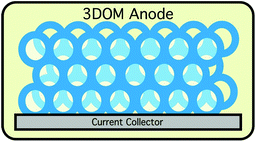Structural and electrochemical properties of three-dimensionally ordered macroporous tin(iv) oxide films
Abstract
This paper presents a colloidal-crystal templating technique to prepare three-dimensionally ordered macroporous (3DOM)

* Corresponding authors
a
Department of Chemistry, University of Minnesota, 207 Pleasant St. SE, Minneapolis, USA
E-mail:
stein@chem.umn.edu
b Department of Chemical Engineering and Materials Science, University of Minnesota, 421 Washington Ave SE, Minneapolis, USA
This paper presents a colloidal-crystal templating technique to prepare three-dimensionally ordered macroporous (3DOM)

 Please wait while we load your content...
Something went wrong. Try again?
Please wait while we load your content...
Something went wrong. Try again?
J. C. Lytle, H. Yan, N. S. Ergang, W. H. Smyrl and A. Stein, J. Mater. Chem., 2004, 14, 1616 DOI: 10.1039/B401890G
To request permission to reproduce material from this article, please go to the Copyright Clearance Center request page.
If you are an author contributing to an RSC publication, you do not need to request permission provided correct acknowledgement is given.
If you are the author of this article, you do not need to request permission to reproduce figures and diagrams provided correct acknowledgement is given. If you want to reproduce the whole article in a third-party publication (excluding your thesis/dissertation for which permission is not required) please go to the Copyright Clearance Center request page.
Read more about how to correctly acknowledge RSC content.
 Fetching data from CrossRef.
Fetching data from CrossRef.
This may take some time to load.
Loading related content
